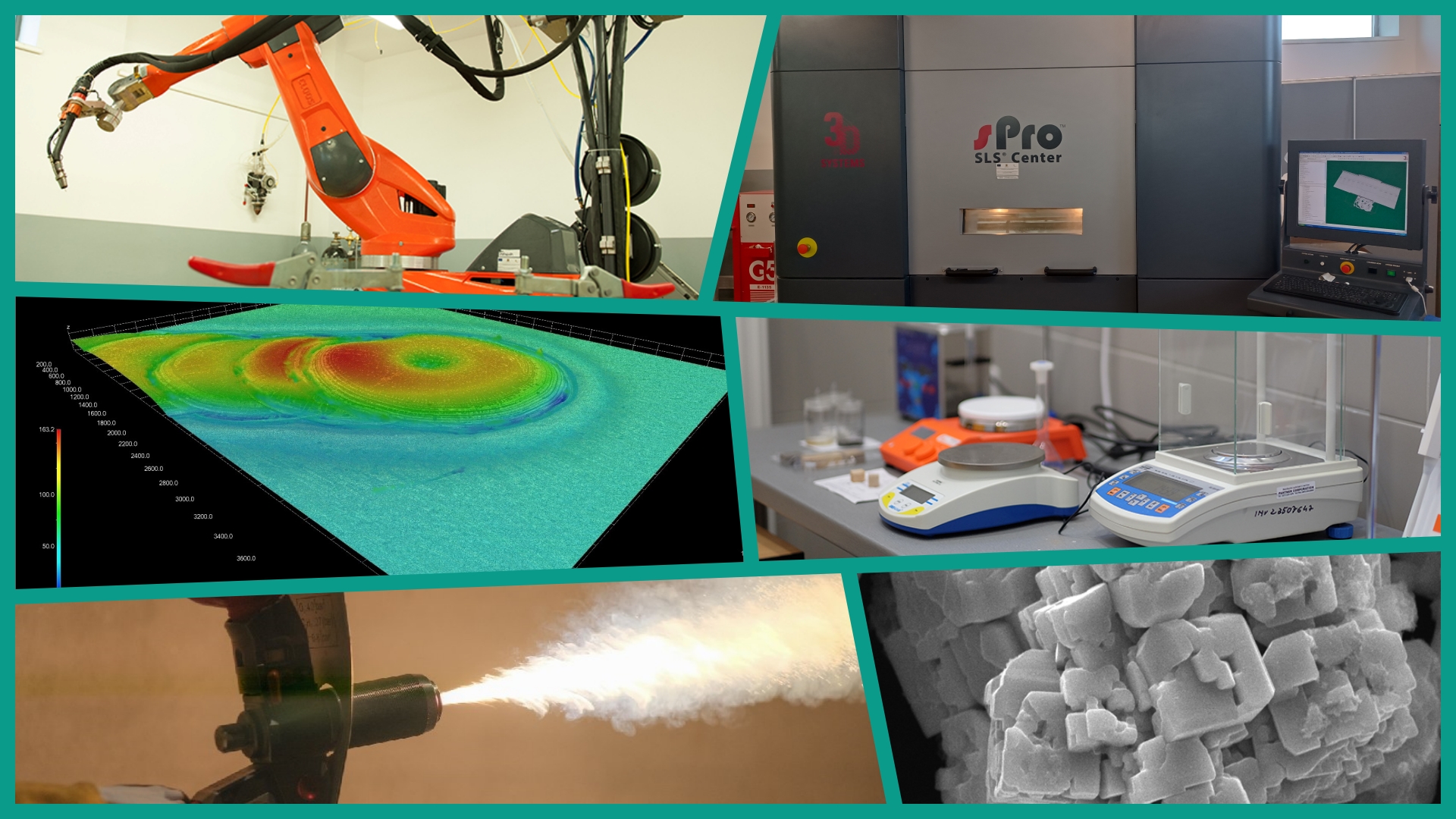Research groups
Advanced Metallic, Ceramic and Composite Materials and Technologies
General objective: To develop research activities on the obtaining, characterization, certification and promotion of advanced metal, ceramic and composite materials, at macro, micro and nanometric scale.

Advanced Welding Eco-Technologies
General objective: Development of new high-performance materials and new production processes and processes for a smart and environmentally friendly industry with applications in welding engineering.

Some of the research topics carried out within the two centers are:
- Spectral analysis of the plasma generated during laser deposition processes, in order to identify in real time the characteristics of the formed layers.
- Characterization of alloys from the Al-Si, Al-Cu, Al-Mg systems, obtained by conventional and advanced technologies (melt-spinning). Analysis of solid-state phase transformations for these alloys, in order to optimize the microstructure and improve the mechanical properties, but also to investigate the possibility of their use in thixo-molding processes.
- Research on risk management, i.e. identification, evaluation and prevention measures of risk factors.
- Behavior of metallic materials after microtexturing.
- Fiber-reinforced composites used in various fields such as aeronautics, automotive, sports equipment, etc., where weight loss while improving mechanical properties is fundamental.
- Development of a new method for assessing ergonomic risks in the industrial field, specific to employees working in narrow spaces with low heights.
- Development of polymeric and composite materials with polymer matrix, obtained by melting, mixing, extrusion or additive manufacturing, using environmentally friendly additives such as cellulosic derivatives, natural minerals and ionic liquids. These materials are tested for resistance to UV radiation, humidity and high temperatures, as well as for the ability to absorb pollutants from industrial environments.
- Development of innovative products, unconventional manufacturing techniques and rapid prototyping – especially for sound-absorbing panel systems.
- Development of surface treatment processes dedicated to improving material properties; synthesis and characterization of thin films obtained by plasma-assisted technological processes (techniques belonging to PVD (Physical Vapor Deposition) and CVD (Chemical Vapor Deposition) methods), diffusion surface treatments, interface processes.
- Development and characterization of thin films and nanomaterials, with a focus on TiO₂ films and Zr layers. Areas of interest include acoustic energy harvesting applications, as well as uses of advanced materials in the biomedical field.
- Development and testing of multifunctional coatings based on titanium and titanium oxide, obtained by sol-gel methods and thermal spraying, with direct applications in corrosion protection of metal components and photocatalysis.
- Development of a technique for obtaining MgMeN nanocomposite coatings by simultaneous reactive magnetron sputtering, with adequate hardness and adhesion to the substrate, with an improved corrosion protection capacity.
- Experiments on the influence of the thermochemical layer on fatigue resistance. Using AI to predict fatigue rupture.
- The influence of heat treatment parameters through advanced technologies (cryogenic, laser or thermochemical treatments, etc.) on the mechanical and structural properties of special steels and alloys.
- Welding charging, thermal treatments, conventional thermochemical and laser beam treatments.
- Obtaining (by PVD methods) and characterizing thin layers with applications targeting their structural, mechanical, tribological, optical characteristics, etc. The influence of the change in the deposition angle on the properties of thin layers such as nitrides, carbides, carbonitrides of some transitional metals.
- Obtaining metal foams using various porogenic agents. The foams have potential in applications such as filtration, heat exchange or impact absorber.
- Obtaining and characterizing photoactive polymer-cement composite materials.
- Obtaining, by casting, ceramic composite materials (with matrix based on clay, bentonite, silicon carbide or alumina), polymer (reinforced with carbon fibers, glass, kevlar) and eco-composites. These materials are investigated for various applications, from ceramic filters and civil constructions to the automotive field and the production of sound-absorbing panels.
- Optimization of welding processes in welded garment companies processing materials classified according to EN15608, taking into account the requirements of the EN3834 and EN ISO1090 families of standards.
- Processing of steel alloy surfaces using laser beam and metal powders - Inconel 718 and Cobalt-based powders. The purpose of the studies is to perform a laser beam deposition to provide a material with a surface more resistant to wear and ballistic impact, their applicability being in the defense and security industry.
- The process of integrating the welding engineer (recent graduate) into the industrial environment.
- Design and characterization of biomaterials for implants and medical devices, with a focus on biocompatibility, corrosion resistance, tissue integration, as well as the development of bioactive and biodegradable materials with advanced medical uses.
- Thermal spraying and laser beam deposition of NiCrBSiFe, CuAlFe, NiAlZn, NiCrAlY, ZrO₂, Al₂O₃, CaO powders with applications in the aeronautical, energy and medical industries.
- Making welded joints of aluminum, copper and nickel alloys, as well as characterizing and testing materials and surfaces to evaluate their properties and behavior under conditions of use.
- Recycling of polyolefins and separation of polypropylene from polyethylene.
- Simulation of the behavior of materials (tool alloys or 3D printed materials) in various conditions.
- Synthesis, processing and characterization of advanced oxidic materials and nanomaterials with electrical, magnetic, structural and optical functional properties. Studies on defect chemistry, effects of entropy and phase equilibria in perovskitic materials based on BiFeO3, BaTiO3, K0.5Na0.5NbO3 and Bi0.5Na0.5TiO3, spinelic materials based on CoFe2O4, CoAl2O4, ZnAl2O4 and fluorite-like structure systems.
- Solutions for the recycling of plastics and the restoration of degraded paper, with applications in heritage conservation.
- Fundamental studies on advanced two-dimensional materials (single-layer or with few layers), especially on two-dimensional MXene materials (Ti2C, Mo2C, Ti2N, Nb3B2, etc.) prepared by chemical corrosion of MAX type ceramic compounds, then incorporated into composite structures, with potential applications in the field of flexible materials or those with high mechanical performance.
- Studies on welding and surface processing with laser, applied to both conventional materials and advanced materials such as HEA or FeCrAl. A specific objective is the pulsed laser welding of different pairs of materials, such as titanium-stainless steel or titanium-aluminum, a topic with direct applicability in the aeronautical industry.
- Electric point resistance welding of materials classified according to EN15608.
- Technologies for the manufacture and reconditioning of parts by welding loading, with a focus on special filler materials for welding/loading/brazing.
- Technologies for obtaining metal foams, environmental protection and recycling processes.
- The use of laser technologies for the processing of metal materials. Studies on the laser deposition process and metal powders, by optimizing the deposition parameters and obtaining new alloyed, amorphous, composite or nano-composite layers.




